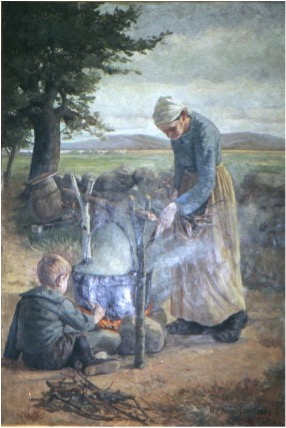
|
"The Soap Maker" by Benjamin T. Newman Photograph by David Emerson Article by Janet Hounsell |
Artist Benjamin T. Newmanwas a native of Bath, ME.He was charmed with Fryeburg's local scenery and became a resident of the town in the early 1900's. He was a faithful draftsman and a skillful colorist and his paintings are realistic and charming. Newman made use of a trailer studio in winter so that he could paint "from life" even in very cold weather. "The Soap Maker," a large work by Newman, hangs in the lobby of the Conway Public Library. Like other taken-for- granted appointments of our day-to-day lives, it is too often ignored, despite the fact that it is a lovely character study which recalls a long-ago, humble, but necessary chore of family life. What is the patient looking, bent-by-toil woman doing, stirring in the big outdoor kettle? And the boy who is feeding the fire with twigs; is he anticipating a meal? Not at all. The woman has probably been making soap for household use since she too was a child. The general stores carried no row upon row of brightly colored boxes of detergent, no box upon box of dainty hand soap. In order to clean bodies, clothing, bedding and houses, someone in each family had to periodically make soap. All of the winter's refuse fat was saved, along with wood ashes. Then in the spring an outdoor camp fire would be prepared, with supports to hold a heavy kettle, capable of holding perhaps four gallons of liquid. The grease was put in the kettle and a hot fire built under it. Close by, a hogshead would be raised on a platform and the wood ashes be put into it. This would then be saturated with pails of water from the spring to make a strong liquid-lye which could be drawn off from the spigot of the hogshead. The lye added to the boiling grease, evolved into "soft soap" - a strong mixture that had to be used with caution, for it not only removed dirt, but was so potent that it was rather hard on the skin! When "boughten" soap first came on the market, many old-time women thought it was a less effective, watered-down type of cleanser, compared to what they were accustomed to. Although it was not costly by today's standards, it also was what grandma called "dear," so many women of her generation continued to make soap for common household use, saving the bars of dainty white stuff for company. My grandmother poured her homemade soap into a large baking tin and then, when it was cool, cut it into bars or hunks. It was quite a long time before soap flakes were made available on the market, but I also recall when grandma would sliver a bar of homemade soap with a paring knife so that it would dissolve and be distributed more evenly in her big laundry tub. Newman, who had studied in Paris, had a studio in Fryeburg Village. Its walls inside were "soft tinted steel" and the outside was shingled and stained green. His painting, "Lunch a la Britaigne in Britaigne," was admitted at the Paris Salon of 1887 and is now hung at the Fryeburg Women's Club Library. Sadly, Newman could not make enough money to live on and had to teach at Fryeburg Academy in order to make ends meet. Perhaps we should not say sadly for he must have imparted a great deal of wisdom to his students. If you chance to be in the Fryeburg or the Conway libraries, don't merely pass by the paintings on the walls simply because, like the traditional schoolroom portrait of George Washington, they have always been there. The work of those long ago talented artists deserves appreciation and so, we believe, do lost arts such as soap making!
Note: The original source of the above information and image can be found here.
To delve more into the soap making process at the time of this painting (and how that process evolved through the ages), check out this blog post by Bob Cottrell.
